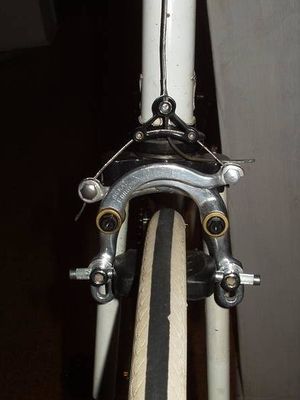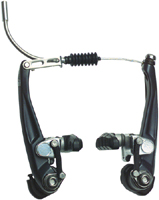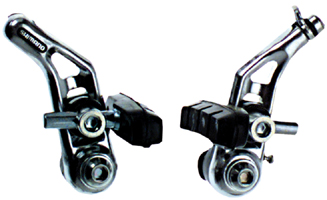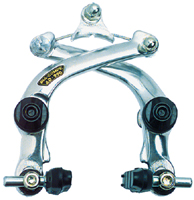Über Felgenbremsen an Anlötsockeln: Unterschied zwischen den Versionen
(→Cantilever- und Zangenbremsen: übersetzt) |
(→Typisierung von Bremsen an Anlötsockeln: Formatierung und Bilder) |
||
| Zeile 37: | Zeile 37: | ||
==Typisierung von Bremsen an Anlötsockeln== | ==Typisierung von Bremsen an Anlötsockeln== | ||
Auf dieser Seite werden nur knappe Informationen gesammelt und es wird auf tiefer gehende Artikel weiterverlinkt: | |||
{| class="wikitable" | |||
|- | |||
| | |||
===Direktzug, "V-Brakes ®"=== | |||
This is the type most commonly used since the mid 1990s. This is the only style of cantilever brake where the cable comes to the cantilever set from one side, rather than down the middle. | This is the type most commonly used since the mid 1990s. This is the only style of cantilever brake where the cable comes to the cantilever set from one side, rather than down the middle. | ||
|[[Datei:BR5664.JPG|center|Direktzugbremse]] | |||
|- | |||
| | |||
===Klassische (Mittelzug) Cantilever-Bremsen=== | |||
These were used on almost all mountain bikes made before the mid 1990s, and are still popular on touring and cyclocross bicycles. This type of brake should be used with a fender, reflector bracket or other device to prevent the transverse cable from snagging the tire if the main cable parts. | These were used on almost all mountain bikes made before the mid 1990s, and are still popular on touring and cyclocross bicycles. This type of brake should be used with a fender, reflector bracket or other device to prevent the transverse cable from snagging the tire if the main cable parts. | ||
See my separate article on adjusting this type of brake | See my separate article on adjusting this type of brake | ||
|[[Datei:BR8787.JPG|center|klassische Cantilever-Bremse]] | |||
U-Brakes | |- | ||
| | |||
===U-Brakes=== | |||
These were fashionable for mountain bikes around 1987, typically mounted underneath the chainstays. The pivot for each brake is between the brake shoe and cable attachment, and so these are not cantilever brakes. | These were fashionable for mountain bikes around 1987, typically mounted underneath the chainstays. The pivot for each brake is between the brake shoe and cable attachment, and so these are not cantilever brakes. | ||
| Zeile 53: | Zeile 60: | ||
(Functionally, U-brakes are very similar to the center-pull caliper brakes popular on sport bikes of the 1960s and '70s.) | (Functionally, U-brakes are very similar to the center-pull caliper brakes popular on sport bikes of the 1960s and '70s.) | ||
|[[Datei:BR1039.jpg|center|U-Brake]] | |||
Roller-Cam | |- | ||
| | |||
===Roller-Cam Bremsen=== | |||
The Roller-cam brake was a predecessor of the U-brake, and had a brief vogue in the mid 1980s. The pivot for each brake is between the brake shoe and cable attachment, and so these are not cantilever brakes. | The Roller-cam brake was a predecessor of the U-brake, and had a brief vogue in the mid 1980s. The pivot for each brake is between the brake shoe and cable attachment, and so these are not cantilever brakes. | ||
(Unit shown is a contemporary roller-cam caliper brake.) | (Unit shown is a contemporary roller-cam caliper brake.) | ||
|[[Datei:BR9100C.JPG|center|Roller-Cam Bremse]] | |||
|} | |||
==Austauschbarkeit von Hebeln== | ==Austauschbarkeit von Hebeln== | ||
Version vom 11. Juli 2018, 09:23 Uhr
In diesem Artikel werden die verschiedenen typen von Bremsen betrachtet, die an Anlötsockeln des Rahmens oder der Gabel befestigt werden und zwei separate Arme je Bremse haben. Im Zusammenhang mit diesem Artikel solltest Du auch Das 1x1 der Felgenbremsen lesen. Dort werden unter anderem auch folgende Aspekte erläutert, die auf alle Arten von Felgenbremsen zutreffen:
- Warum Felgenbremsen?
- Typen von Felgenbremsen
- Zentrieren
- Hebelübersetzung
- Geräusche/Quietschen
- Typen von Bremsschuhen
- Einstellen der Bremsschuhe
Die meisten Probleme mit Felgenbremsen werden durch exzessive Reibung oder schlechte Montage der Züge verursacht. Schlechte Einstellung oder Bremsen geringer Qualität sind zumeist keine Gründe.
- Siehe auch
- Züge - über dir richtige Montage von Zügen und Bremshebeln.
Felgenbremsentypisierung
Es gibt mehrere grundlegende Arten von Felgenbremsen
Cantilever Bremsen haben zwei getrennte Arme, die jeder für sich auf jeder Seite des Rahmen oder der Gabel montiert werden. Nicht jede Cantilever Bremse sieht so aus wie auf dem Bild, sie haben jedoch alle zwei getrennte Arme. Sie können ausschließlich an Fahrrädern montiert werden, die dafür vorbereitet sind, da man spezielle Bremssockel benötigt.
Manche Bremsen, deren Gelenke auf Sockel montiert werden, haben Bremsschuhe und Züge auf gegenüberliegenden Seitem des jeweiligen Gelenks und ähneln Zangenbremsen.
Diese haben einen in sich geschlossenen Mechanismus, der mit einer einzelnen Schraube am Rahmen (oder der Gabel) oberhalb des Reifens befestigt wird. Die Bremsarme verlaufen nach unten und müssen lang genug sein, um um den Reifen herumzureichen. Das Gelenk kann dabei in der Mitte um die Befestigungsschraube sein, oder auch weiter Gelenke aufweisen.
- Siehe auch
- Montage und Justage von Zangenbremsen
- Cantilever-Bremsen einstellen
- Einstellen von U-Brakes
- Einstellen von Rolle-Cam Bremsen
Typisierung von Bremsen an Anlötsockeln
Auf dieser Seite werden nur knappe Informationen gesammelt und es wird auf tiefer gehende Artikel weiterverlinkt:
Direktzug, "V-Brakes ®"This is the type most commonly used since the mid 1990s. This is the only style of cantilever brake where the cable comes to the cantilever set from one side, rather than down the middle. |
|
Klassische (Mittelzug) Cantilever-BremsenThese were used on almost all mountain bikes made before the mid 1990s, and are still popular on touring and cyclocross bicycles. This type of brake should be used with a fender, reflector bracket or other device to prevent the transverse cable from snagging the tire if the main cable parts. See my separate article on adjusting this type of brake |
|
U-BrakesThese were fashionable for mountain bikes around 1987, typically mounted underneath the chainstays. The pivot for each brake is between the brake shoe and cable attachment, and so these are not cantilever brakes. U-brakes have had a bit of a revival in the last few years for use on freestyle bicycles (Functionally, U-brakes are very similar to the center-pull caliper brakes popular on sport bikes of the 1960s and '70s.) |
|
Roller-Cam BremsenThe Roller-cam brake was a predecessor of the U-brake, and had a brief vogue in the mid 1980s. The pivot for each brake is between the brake shoe and cable attachment, and so these are not cantilever brakes. (Unit shown is a contemporary roller-cam caliper brake.) |
Austauschbarkeit von Hebeln
Direct-pull cantilevers require special brake levers. Direct-pull brake levers pull the cable twice as far, half as hard. It is not generally safe to mix and match levers/cables between direct pull and other types for this reason.
- Conventional brake levers used with direct-pull cantilevers will usually not pull enough cable to stop in wet conditions without bottoming out against the handlebars. In dry conditions, they either won't work, or will grab too suddenly.
- Direct-pull brake levers used with any other type of brakes will feel nice and solid when you squeeze them, but you'll need to squeeze twice as hard to stop as you should, so unless you are a lightweight rider with gorilla-like paws, this combination isn't safe either.
Siehe auch
- Kompatibilität von Cantilever Bremsen (Tabelle)
- Das 1x1 der Felgenbremsen
- Züge - über dir richtige Montage von Zügen und Bremshebeln.
- Einstellen von Direktzugbremsen
- Einstellen von Cantilever-Bremsen
- Einstellen von U-Brakes
- Einstellen von Roller-Cam Bremsen
Quelle
Dieser Artikel basiert auf dem Artikel [http://sheldonbrown.com/cantilever-adjustment.html About Bicycle Brakes with Brazed-on Fittings] von der Website Sheldon Browns. Originalautor des Artikels ist Sheldon Brown.
- Sattelstützenmaße
- Knarzen, Knacken und Quietschen
- Ritzelabstände (Tabelle)
- Auswechselbarkeit von Vierkant-Kurbelaufnahmesystemen bei Innenlagern
- Kettenlinienstandards (Tabelle)
- Ein bequemer Sattel
- Nabenbreiten (Tabelle)
- Alles über Nabenschaltungen
- Shimano Nexus und Alfine Acht-Gang-Naben
- Reifengrößen





